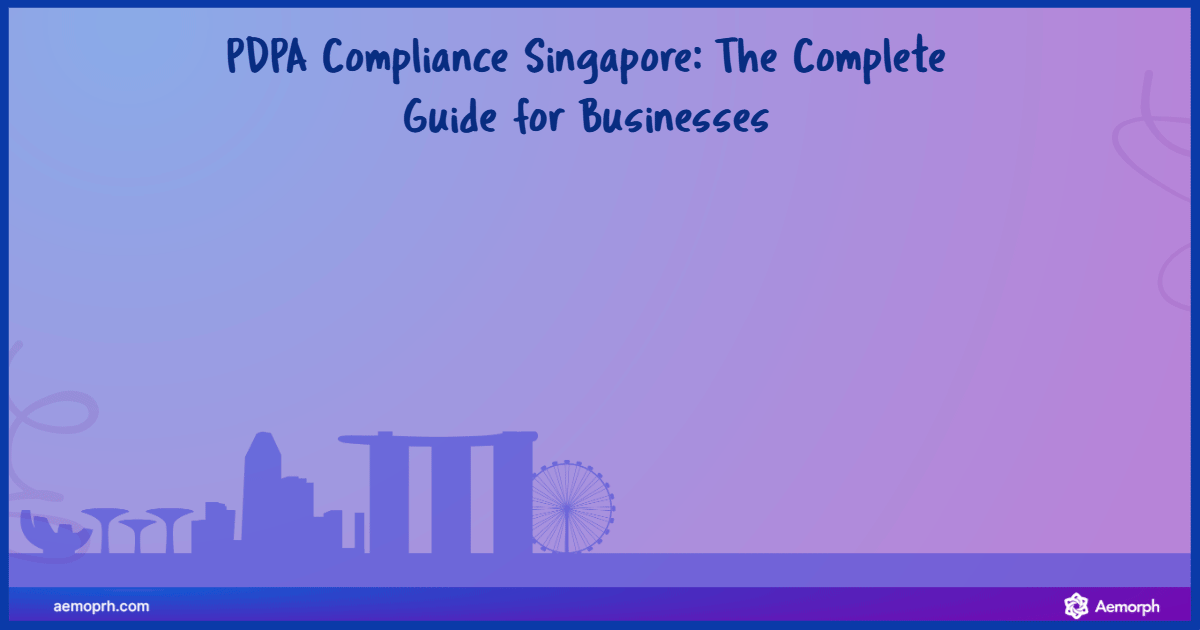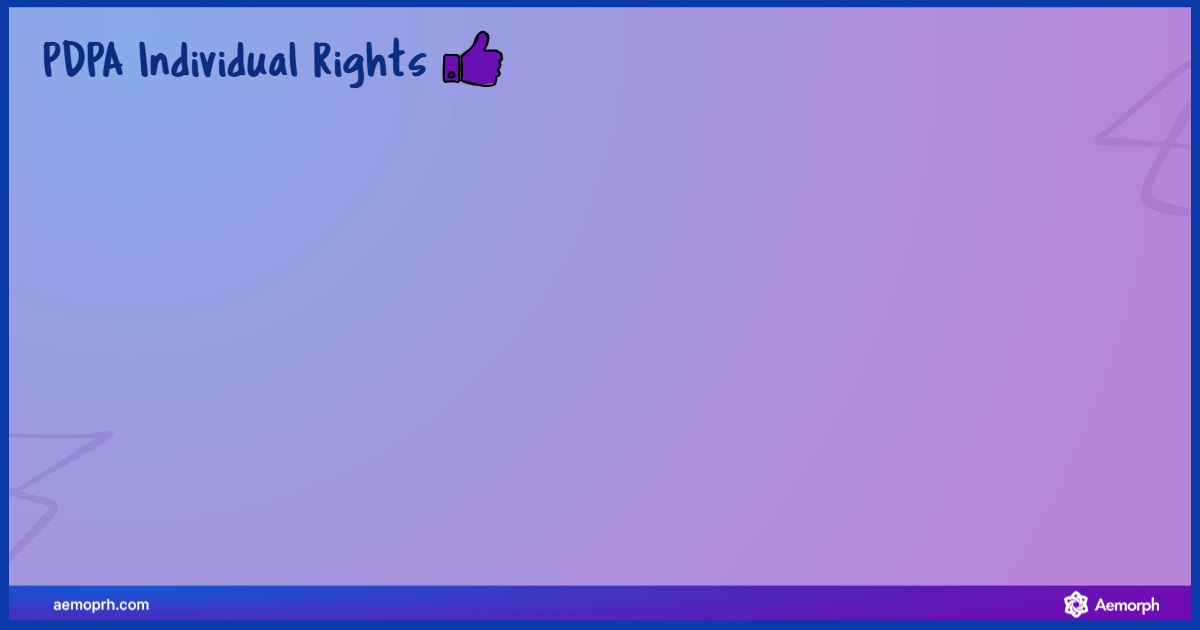
In today’s digital economy, data is currency, and trust is the foundation that keeps it valuable. As organisations in Singapore increasingly rely on personal data to drive innovation and growth, they also face mounting responsibilities to safeguard that information. The Personal Data Protection Act (PDPA) outlines the rules and obligations governing how businesses must collect, use, disclose, and protect personal data.
This guide breaks down PDPA compliance for businesses of all sizes, from startups and SMEs to multinational corporations operating in Singapore. This comprehensive resource will help you understand the law, avoid costly breaches, and build a culture of data accountability that earns customer trust.
What Is PDPA Compliance?

The PDPA governs how businesses in Singapore collect, use, disclose, and manage personal data. Originally enacted in 2012, the Act came into full force in 2014, with significant updates introduced in 2020 and implemented progressively through 2021 and beyond.
Who Must Comply?
All private sector organisations in Singapore that handle personal data, whether digital or paper-based, must comply. This includes SMEs, startups, MNCs, and non-profits. Exceptions apply to public agencies, employee data within job roles, and personal or domestic use of data.
Objectives of the PDPA
- To protect individuals’ personal data from misuse and unauthorised access.
- To maintain trust between individuals and organisations handling personal data.
- To support Singapore’s reputation as a trusted business hub by regulating data flows
Core Obligations of the PDPA
The PDPA applies to personal data in both electronic and non-electronic formats but generally excludes data used solely for personal or domestic purposes, data of employees acting in their employment capacity, public agencies, and business contact information such as business phone numbers and email addresses.
- Purpose Limitation: Organisations may only collect, use, or disclose personal data for purposes that the individual has been informed of and consented to, and that a reasonable person would consider appropriate in the circumstances.
- Notification Obligation: Organisations must notify individuals of the purposes for which their personal data is being collected, used, or disclosed before or at the time of collection.
- Consent Obligation: Consent must be obtained from individuals before collecting, using, or disclosing their personal data. Individuals must also be allowed to withdraw consent at any time, with organisations informing them of the consequences of withdrawal and ceasing data processing accordingly.
- Access and Correction Obligation: Individuals have the right to request access to their personal data and to request corrections to any inaccurate or incomplete data. Organisations must facilitate these requests promptly and accurately.
- Accuracy Obligation: Organisations must make reasonable efforts to ensure that personal data collected is accurate and complete, especially if used to make decisions affecting the individual or disclosed to other organisations.
- Protection Obligation: Organisations must protect personal data in their possession or control by making reasonable security arrangements to prevent unauthorised access, collection, use, disclosure, copying, modification, or disposal.
- Retention Limitation Obligation: Personal data must only be retained for as long as necessary to fulfil the purpose for which it was collected or to meet legal or business requirements. Once no longer needed, data must be securely destroyed or anonymised.
- Transfer Limitation Obligation: When transferring personal data outside Singapore, organisations must ensure that the receiving party provides a comparable standard of data protection as required by the PDPA.
- Accountability Obligation: Organisations must implement policies and practices to ensure compliance with the PDPA, designate a Data Protection Officer (DPO), provide staff training, and make information about their data protection policies and practices publicly available.
- Data Breach Notification Obligation: Organisations must notify the Personal Data Protection Commission (PDPC) and affected individuals of any data breach that poses a risk of significant harm or impact within three calendar days of determining the severity of the breach.
Key Individual Rights Under the PDPA

Under Singapore’s Personal Data Protection Act (PDPA), individuals are granted several important rights over their personal data held by organisations. These rights are designed to give individuals control and transparency regarding how their personal data is handled:
- Right to Access: Individuals can request access to their personal data that an organisation holds or controls. Upon request, organisations must provide:
- The personal data collected
- Information on how the data was used or disclosed in the past year
The data should be provided in a readable format, and organisations may charge a reasonable fee for access requests. However, access can be refused in specific cases, such as when it would reveal personal data about another individual, threaten national interest, or if the request is malicious.
- Right to Correction: Individuals have the right to request correction of inaccurate personal data. Organisations must correct the data as soon as practicable and notify other organisations to whom the data was disclosed within the past year, unless those organisations do not need the correction. Unlike access requests, no fee can be charged for correction requests. Organisations may refuse correction only on reasonable grounds.
- Right to Withdraw Consent: Individuals can withdraw their consent for the collection, use, or disclosure of their personal data at any time by informing the organisation. Organisations must notify individuals of the consequences of withdrawing consent and cease processing the data accordingly.
- Right to Data Portability: Individuals can request that their personal data be transferred to another organisation. The organisation must comply with such requests following any procedural requirements.
- Right to Erasure (Right to Delete): Individuals can ask organisations to delete their personal data. Organisations must delete data when it is no longer necessary for business or legal purposes or upon request, subject to exceptions under the law.
- Right to be Informed (Notification Obligation): While the PDPA does not explicitly define a “right to be informed,” organisations have a notification obligation to inform individuals of the purposes for collecting, using, or disclosing their personal data before doing so. They must also provide information about how personal data was used or disclosed in the past year upon request.
Additional Notes
- Organisations must respond to access or correction requests within 30 days or notify the individual of the expected response time.
- Certain exceptions apply to these rights to protect the privacy of other individuals, national security, or in cases of malicious intent.
- The PDPA also emphasises accuracy, requiring organisations to make reasonable efforts to ensure personal data is accurate and complete.
Enforcement & Penalties
If an organisation breaches Singapore’s Personal Data Protection Act (PDPA), it faces significant enforcement actions and penalties administered by the Personal Data Protection Commission (PDPC).
- Financial Penalties:
The PDPC can impose financial penalties on organisations found to have intentionally or negligently violated PDPA obligations. The maximum fine is:- SGD 1 million, or
- 10% of the organisation’s annual turnover in Singapore, whichever is higher (applicable to organisations with local turnover exceeding SGD 10 million).
This penalty framework, effective from October 2022, reflects a substantial increase from the previous fixed SGD 1 million cap, aligning Singapore’s regime with stringent global standards like the GDPR.
- Factors Influencing Penalty Amount: When determining the quantum of fines, the PDPC considers:
- The nature, gravity, and duration of the breach
- The sensitivity and type of personal data affected
- Actions taken by the organisation to mitigate harm and the timeliness of those actions
- The proportionality and deterrence effect of the penalty
- The financial impact on the organisation and its ability to continue operations.
- Other Enforcement Actions: Beyond fines, the PDPC can issue directives requiring organisations to:
- Cease unlawful data collection, use, or disclosure
- Destroy unlawfully collected data
- Correct inaccurate personal data
- Provide individuals access to their data
- Implement system and policy changes to ensure future compliance
- Undergo audits or extended oversight.
- Criminal Liability: In cases of willful misconduct or failure to comply with PDPA directions, organisations and responsible individuals may face criminal sanctions, including fines up to SGD 50,000 and imprisonment.
- Reputational Damage: Breaches can severely damage an organisation’s reputation and erode customer trust, which can have long-term business impacts beyond regulatory penalties.
Mandatory Breach Notification Process

Organisations are required to notify both the Personal Data Protection Commission (PDPC) and affected individuals within three calendar days if the data breach meets either of the following conditions:
- The breach is likely to result in significant harm to the individuals affected, or
- The breach involves the personal data of 500 or more individuals.
Step-by-Step Incident Response
When a data breach occurs, time is of the essence. Organisations must respond swiftly and systematically to contain the damage, ensure compliance with legal obligations, and maintain stakeholder trust. The following steps outline a structured approach to incident response:
1. Immediate Containment and Assessment
The priority is to contain the incident to prevent further data loss or unauthorised access. This typically involves isolating affected systems, suspending compromised user accounts, or disconnecting network access where appropriate. Simultaneously, conduct an initial assessment to understand the scope and nature of the breach, including the types of data compromised, the number of individuals affected, and the potential impact.
2. Root Cause Analysis
Once the situation is stabilised, initiate a thorough investigation to identify the underlying cause of the breach. Determine whether the incident resulted from system vulnerabilities, human error, or procedural lapses. Understanding the root cause is essential for effective remediation and future prevention.
3. Mandatory Notification
If the breach meets the legal threshold outlined earlier, the organisation must notify the PDPC and the affected individuals within three calendar days. The notification should provide a clear and factual summary of the breach, including the types of data involved, the number of individuals impacted, and the corrective actions taken to mitigate risk and prevent recurrence.
4. Implementation of Corrective Measures
Based on the findings from the root cause analysis, take immediate steps to remediate the vulnerabilities that led to the breach. This may include applying security patches, revising access controls, enhancing authentication protocols, or updating internal policies. If the breach was caused by human or procedural error, provide refresher training to relevant employees to reinforce proper data handling practices.
5. Stakeholder Communication
Effective communication with stakeholders is critical. Prepare clear, concise, and non-technical messages for customers, partners, and vendors. While maintaining transparency, avoid language that implies liability. Instead, focus on explaining what happened, the steps being taken to address the issue, and what individuals can do to protect themselves, such as monitoring accounts or resetting passwords.
6. Post-Incident Review and Improvement
After the situation is resolved, conduct a comprehensive post-incident review. This should include a full timeline of events, decisions made during the response, and lessons learned. Use these insights to update your breach response protocols and conduct simulated drills to test future readiness and improve your organisation’s data protection strategy.
Tools & Resources
To effectively manage PDPA compliance, businesses should leverage trusted platforms, templates, and regulatory portals. These resources simplify implementation, reduce risks, and help you stay ahead of regulatory changes.
- PDPC Guidelines: Refer to the Personal Data Protection Commission’s official website for comprehensive advisory guidelines, sector-specific regulations, and legal updates.
- SecurePrivacy: A privacy compliance platform providing tools for cookie consent, privacy policy management, and breach notification automation. Visit secureprivacy.ai.
- DNC Registry Portal: For checking and managing marketing contact lists in compliance with the Do Not Call provisions.
Turning Compliance into a Competitive Advantage
Achieving PDPA compliance is about building a resilient, customer-centric business in the digital age. As data protection laws evolve, so too must your organisation’s approach to privacy and security.
Here’s how to put this guide into action:
- Conduct a PDPA compliance audit to assess your current data protection and privacy policies and practices.
- Appoint or empower your Data Protection Officer (DPO) to oversee implementation and training.
- Update your privacy notices and consent processes to align with current regulations.
- Establish clear incident response plans and conduct regular drills to ensure an effective response.
- Leverage tools and platforms like SecurePrivacy and the PDPC portal to stay updated and reduce manual work.
Remember, compliance is a journey, not a checkbox. By embedding privacy into your culture and operations, you not only protect your business but also strengthen relationships with customers, employees, and partners.









